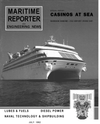
Soaring Shipbuilding Demand To Challenge Shipyard Capacity
Drewry Expects 160 Million CGRT To Be Ordered In Next 10 Years Though current freight rates give many shipowners and financiers cause for concern and orders for new ships have slowed down, the medium to long term outlook for both the shipping and shipbuilding industries is encouraging. Not only is world trade expected to expand, albeit modestly, but the current age of the world fleet combined with the effects of new environmental and safety legislation should exert a positive influence on world newbuilding demand during the remainder of the 1990s. This will not only present a challenge to the world's shipyards to meet demand, but also to owners who will need the means of financing newbuildings.
In the period up to 2001, total newbuilding demand is estimated to be almost 160 million compensated gross registered tonnage (cgrt), with 75 percent of this total expected to be delivered in the period 1996-2001. Current shipbuilding output is running at about 12 million cgrt per year and estimated current annual capacity is 15 million cgrt per year. On the surface, with demand in the late 1990s expected to be in excess of 23 million cgrt per annum, there appears to be a shortfall. But, given advances in shipbuilding technology and productivity, the widespread return to series production and also the doubts surrounding the validity of using cgrt as a realistic measure of shipbuilding capacity (the current coefficient were set in 1983), the latest Drewry report, "World Shipbuilding— The Next Ten years: Can the Challenge Be Met?" concludes that the industry will be able to cope with the anticipated increase in demand without constructing new yards or reopening dormant facilities.
The major driving force for increased newbuilding demand will be the aging world fleet together with the tightening of environmental and safety legislation which will shorten the "economic" life of a significant volume of tonnage. Shipping is now well and truly back in the political arena. Besides examining the age structure of the world fleet, assessing replacement demand and demand generated by the growth of world seaborne trade, the report also considers regional construction patterns, advances in shipyard productivity, the role of government subsidies and the development of newbuilding prices. Drewry expects prices to harden considerably throughout the forecast period and does not foresee the emergence of any new significant shipbuilder with the ability to destabilize the newbuilding market as occurred in the early 1980s when South Korea entered the world scene. Drewry assumes that the newbuilding market will be demand-driven during the rest of the 1990s rather han supply-driven, as was the case 10 years ago.
The report also addresses the crucial question of newbuilding finance.
Given the volume of fleet replacement and rising real prices for new ships, where will shipowners find the huge sums necessary? At current prices the financial implications of the newbuilding demand estimated in the report indicate that by 2001 shipowners will have to raise around $355 billion. Shipping finance is expected to become significantly tighter as the decade progresses and, with commercial banks becoming less generous, owners will have to become more inventive at raising funds for newbuildings and will almost certainly have to provide more equity.
This will require freight rates to be increased to take account of higher newbuilding prices and also higher costs brought about by changes in the operating environment. The yards themselves will have to become even more involved in financing if they wish to exploit the potential market.
The OECD is under strong pressure from the U.S. to abolish all newbuilding subsidies, including government-backed export credit.
If governments take the opportunity to disengage from ship subsidization altogether, this popular form of finance would disappear. The EC is also committed to the reduction and ultimately the abolition of subsidies.
Leasing is a valuable potential source of newbuilding finance and is clearly in favor among some prominent owners, but there needs to be a greater cooperation between lessors and lessees for this form of financing to increase substantially.
Because of the high risk factor, the few banks which remain active in this capital intensive market in the 1990s will stick more closely to conservative lending policies. They will strictly apply the same criteria to marine financing as to their other long term activities. Undercapitalized one-ship companies and financially weak owners will find it hard to persuade banks to grant loans.
Most owners will have to provide more equity which will be dependent on the health of the market.
Other stories from July 1992 issue
Content
- Markey Machinery Supplies Hawser Winch For LOOP Emergency Response Vessel page: 9
- Siemens Division Supplies Integrated Electric Propulsion System For B.C. Ferry page: 9
- $75 Million Cable Ship Launched By AT&T/ Teleglobe At FELS page: 10
- U.S. Owners Could Place $5 Billion In New Ship Orders page: 11
- Stolt-Nielsen Adds Two Inland Tankers; Acquires Comex Services page: 12
- New Oceanographic Ship Christened By MSC At Avondale page: 13
- Shaver Awards Z-Drive Tug Contract To Martinac page: 13
- Atlantic Marine Delivers 1,200-Passenger 'Empress/ New Illinois Casino Boat page: 14
- U.S.-FLAG CRUISING: READY TO SAIL? page: 16
- Unitor Offers Shipowners CFC 'Phase-Out7 Concept page: 19
- DIESEL POWER page: 21
- Great Lakes Towing Overhauls Army Tug, Expands Yard Facilities page: 28
- FMC Seeks Comments On Exempting Military Rates From ' 8 4 Ship Act page: 29
- Lugger Diesels Give Passenger Boats Economical High Speed page: 32
- CG Says New Regulations Will Remove Substandard Tankers And Operators page: 32
- Future Repair & Modernization Of U.S. Navy Ships page: 33
- Distribution Of Navy Repair Work page: 34
- ECO Delivers Two PC Ship Simulators To Navy page: 36
- Eighth LSD Class Ship Commissioned At Avondale page: 37
- ANNUAL GUIDE TO FUELS and LUBES page: 38
- COMSAT Introduces C-Linksm Dial-In Service page: 46
- NOR-FISHING '92 page: 48
- Soaring Shipbuilding Demand To Challenge Shipyard Capacity page: 49
- CREDIT IN THE BUNKER BUSINESS Pitfalls, Problems, Techniques And Solutions page: 52
- Singapore's Marine Industry Posts $ 1 . 9 Billion Growth page: 52
- Singapore Buys $12 Million VTS From Norcontrol page: 54
- FMC Issues Notice For 3 Proposed Rule Changes page: 54
- Fire Safety Actuators From N e w Joint Venture/ Stockham-Ficotech page: 55
- Siemens Launches New Industrial Systems Division page: 55
- Singmarine Launches One Of WorlcTs Largest Well Stimulation Vessels For The Western Company page: 55
- Mar Ad's Management Control Over Title XI Vessels page: 56
- HEIDRUN —A Breakthrough For Concrete Technology page: 58
- AWSC Helps 2nd-Tier Shipyards Comply With U.S. Disabilities Act page: 60
- PPM Cranes To Produce First U.S.-Built Container Reach Stacker page: 60
- SECONDHAND SHIPS: Market Sector Prospects And Investment Options During The 1990s page: 61
- Ashtech Ranger Receiver: Compact GPS Solution page: 62
- HMS Marine Introduces Halon Containment Curtain page: 62
- North Sea To Black Sea Waterway Set To Open page: 63
- New Marine Turbine For Fast Ferries From Solar Turbines page: 64
- Edson Offers Free Diaphragm Pump Catalog page: 64
- Leevac To Build Casino Boat To Rodney E. Lay Design page: 65
- Finnyards Receives 2nd $130 Million Multipurpose Icebreaker Order page: 65
- Futuristic Radisson Diamond: 21st Century Cruise Ship Delivered By Finnyards page: 66
- Flender Werft Delivers 1,724-TEU Boxship page: 67
- Lakes Shipping Affected By Low Water Levels page: 67
- MarAd Publishes Final Rule On Regulated Transactions page: 68

